Management Accounting Report: Systems, Techniques and Planning Tools
VerifiedAdded on 2021/02/19
|16
|3806
|32
Report
AI Summary
This report delves into the realm of management accounting, examining its core principles and applications within a construction company, Assael Architecture. It initiates with a definition of management accounting, its systems, and its distinctions from financial accounting. The report then meticulously explores various management accounting systems, including cost accounting, job costing, price optimization, and inventory management, highlighting their significance and practical applications. Furthermore, it elucidates diverse management accounting reporting methods, such as performance reports, accounts receivable aging reports, budget reports, and cost managerial accounting reports. The report also incorporates profit and cost calculations using marginal and absorption costing techniques. Finally, it provides a detailed analysis of different planning tools like budgeting, zero-based budgeting, and incremental budgeting, along with their advantages, disadvantages, and behavioural implications. The report emphasizes how these tools contribute to effective decision-making and operational control within an organization.
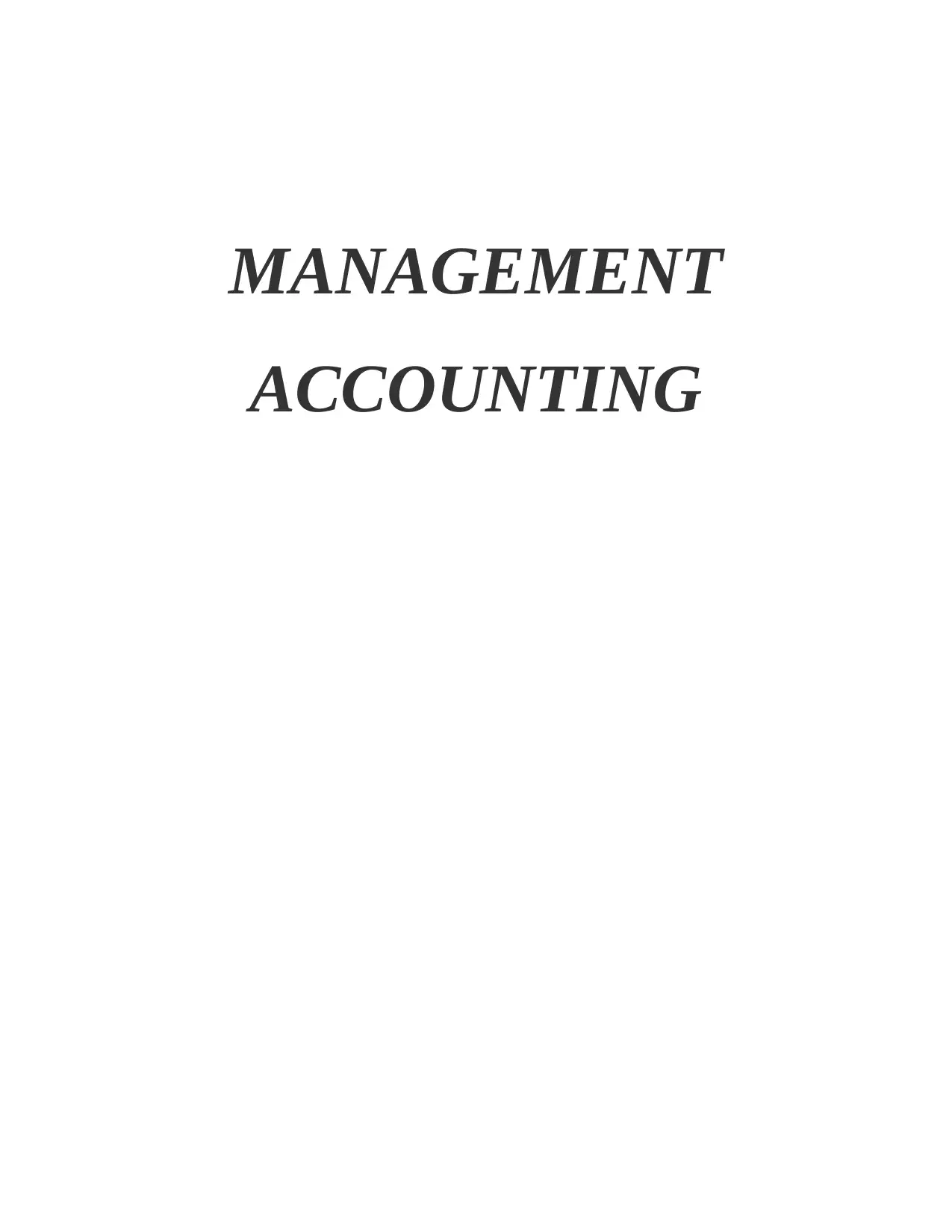
MANAGEMENT
ACCOUNTING
ACCOUNTING
Paraphrase This Document
Need a fresh take? Get an instant paraphrase of this document with our AI Paraphraser
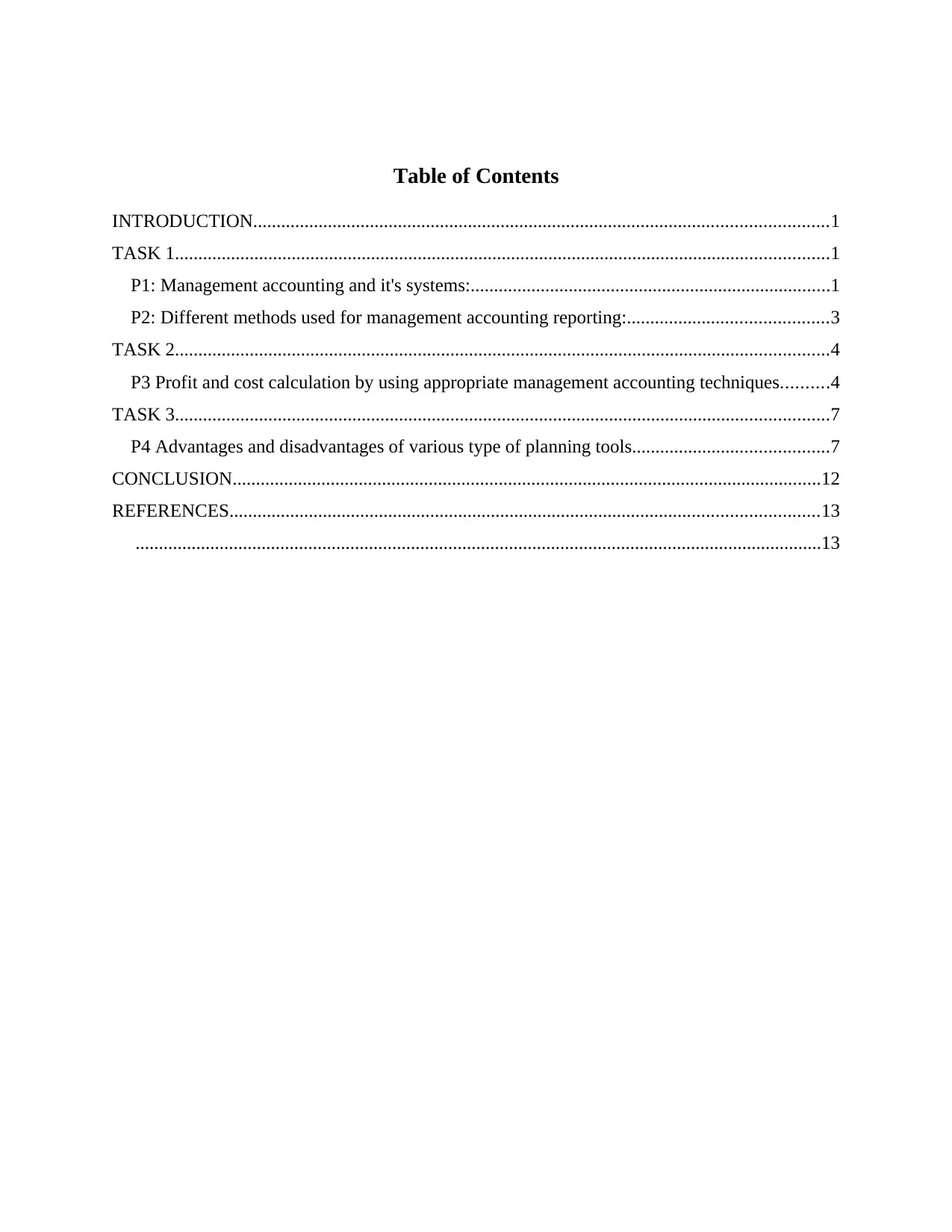
Table of Contents
INTRODUCTION...........................................................................................................................1
TASK 1............................................................................................................................................1
P1: Management accounting and it's systems:.............................................................................1
P2: Different methods used for management accounting reporting:...........................................3
TASK 2............................................................................................................................................4
P3 Profit and cost calculation by using appropriate management accounting techniques..........4
TASK 3............................................................................................................................................7
P4 Advantages and disadvantages of various type of planning tools..........................................7
CONCLUSION..............................................................................................................................12
REFERENCES..............................................................................................................................13
...................................................................................................................................................13
INTRODUCTION...........................................................................................................................1
TASK 1............................................................................................................................................1
P1: Management accounting and it's systems:.............................................................................1
P2: Different methods used for management accounting reporting:...........................................3
TASK 2............................................................................................................................................4
P3 Profit and cost calculation by using appropriate management accounting techniques..........4
TASK 3............................................................................................................................................7
P4 Advantages and disadvantages of various type of planning tools..........................................7
CONCLUSION..............................................................................................................................12
REFERENCES..............................................................................................................................13
...................................................................................................................................................13

⊘ This is a preview!⊘
Do you want full access?
Subscribe today to unlock all pages.

Trusted by 1+ million students worldwide
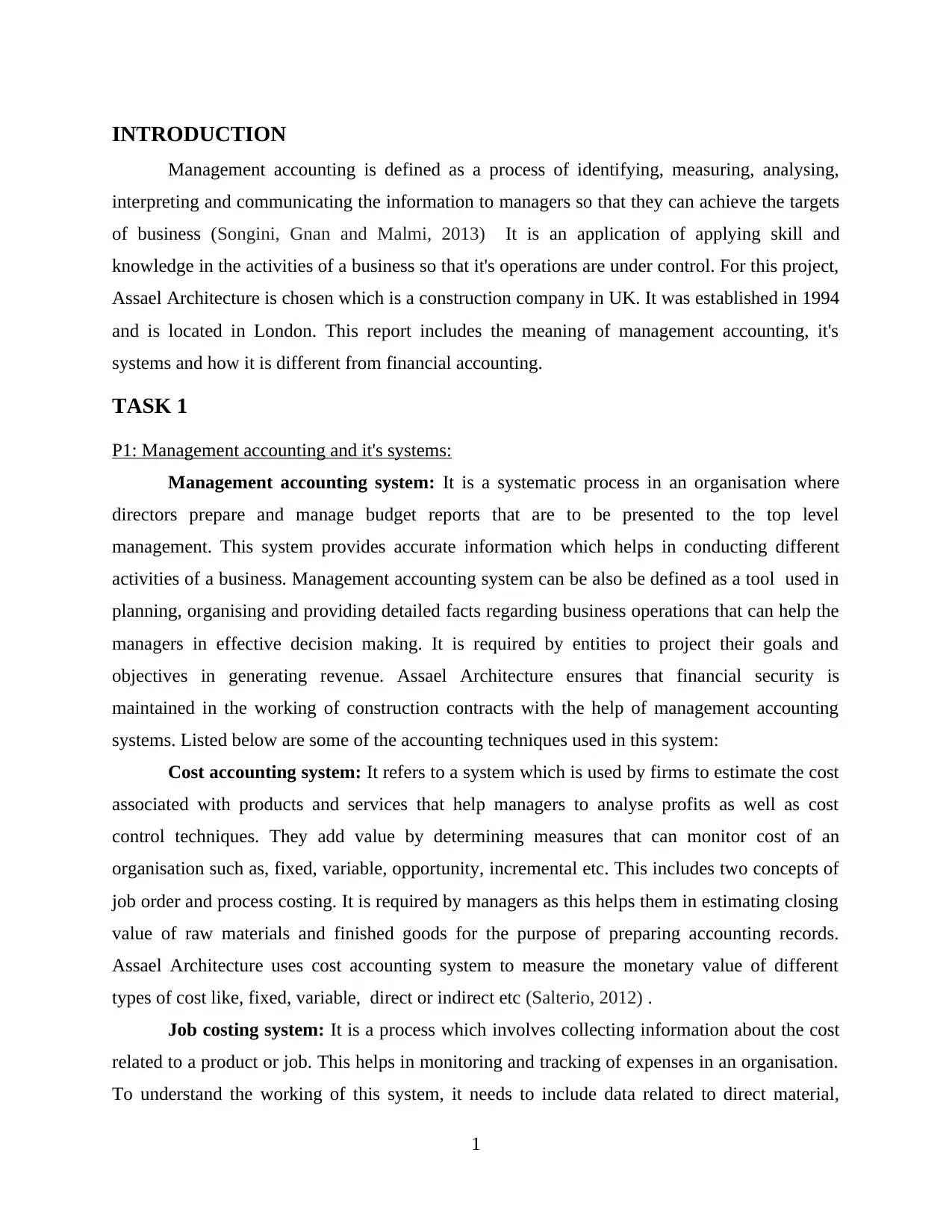
INTRODUCTION
Management accounting is defined as a process of identifying, measuring, analysing,
interpreting and communicating the information to managers so that they can achieve the targets
of business (Songini, Gnan and Malmi, 2013) It is an application of applying skill and
knowledge in the activities of a business so that it's operations are under control. For this project,
Assael Architecture is chosen which is a construction company in UK. It was established in 1994
and is located in London. This report includes the meaning of management accounting, it's
systems and how it is different from financial accounting.
TASK 1
P1: Management accounting and it's systems:
Management accounting system: It is a systematic process in an organisation where
directors prepare and manage budget reports that are to be presented to the top level
management. This system provides accurate information which helps in conducting different
activities of a business. Management accounting system can be also be defined as a tool used in
planning, organising and providing detailed facts regarding business operations that can help the
managers in effective decision making. It is required by entities to project their goals and
objectives in generating revenue. Assael Architecture ensures that financial security is
maintained in the working of construction contracts with the help of management accounting
systems. Listed below are some of the accounting techniques used in this system:
Cost accounting system: It refers to a system which is used by firms to estimate the cost
associated with products and services that help managers to analyse profits as well as cost
control techniques. They add value by determining measures that can monitor cost of an
organisation such as, fixed, variable, opportunity, incremental etc. This includes two concepts of
job order and process costing. It is required by managers as this helps them in estimating closing
value of raw materials and finished goods for the purpose of preparing accounting records.
Assael Architecture uses cost accounting system to measure the monetary value of different
types of cost like, fixed, variable, direct or indirect etc (Salterio, 2012) .
Job costing system: It is a process which involves collecting information about the cost
related to a product or job. This helps in monitoring and tracking of expenses in an organisation.
To understand the working of this system, it needs to include data related to direct material,
1
Management accounting is defined as a process of identifying, measuring, analysing,
interpreting and communicating the information to managers so that they can achieve the targets
of business (Songini, Gnan and Malmi, 2013) It is an application of applying skill and
knowledge in the activities of a business so that it's operations are under control. For this project,
Assael Architecture is chosen which is a construction company in UK. It was established in 1994
and is located in London. This report includes the meaning of management accounting, it's
systems and how it is different from financial accounting.
TASK 1
P1: Management accounting and it's systems:
Management accounting system: It is a systematic process in an organisation where
directors prepare and manage budget reports that are to be presented to the top level
management. This system provides accurate information which helps in conducting different
activities of a business. Management accounting system can be also be defined as a tool used in
planning, organising and providing detailed facts regarding business operations that can help the
managers in effective decision making. It is required by entities to project their goals and
objectives in generating revenue. Assael Architecture ensures that financial security is
maintained in the working of construction contracts with the help of management accounting
systems. Listed below are some of the accounting techniques used in this system:
Cost accounting system: It refers to a system which is used by firms to estimate the cost
associated with products and services that help managers to analyse profits as well as cost
control techniques. They add value by determining measures that can monitor cost of an
organisation such as, fixed, variable, opportunity, incremental etc. This includes two concepts of
job order and process costing. It is required by managers as this helps them in estimating closing
value of raw materials and finished goods for the purpose of preparing accounting records.
Assael Architecture uses cost accounting system to measure the monetary value of different
types of cost like, fixed, variable, direct or indirect etc (Salterio, 2012) .
Job costing system: It is a process which involves collecting information about the cost
related to a product or job. This helps in monitoring and tracking of expenses in an organisation.
To understand the working of this system, it needs to include data related to direct material,
1
Paraphrase This Document
Need a fresh take? Get an instant paraphrase of this document with our AI Paraphraser
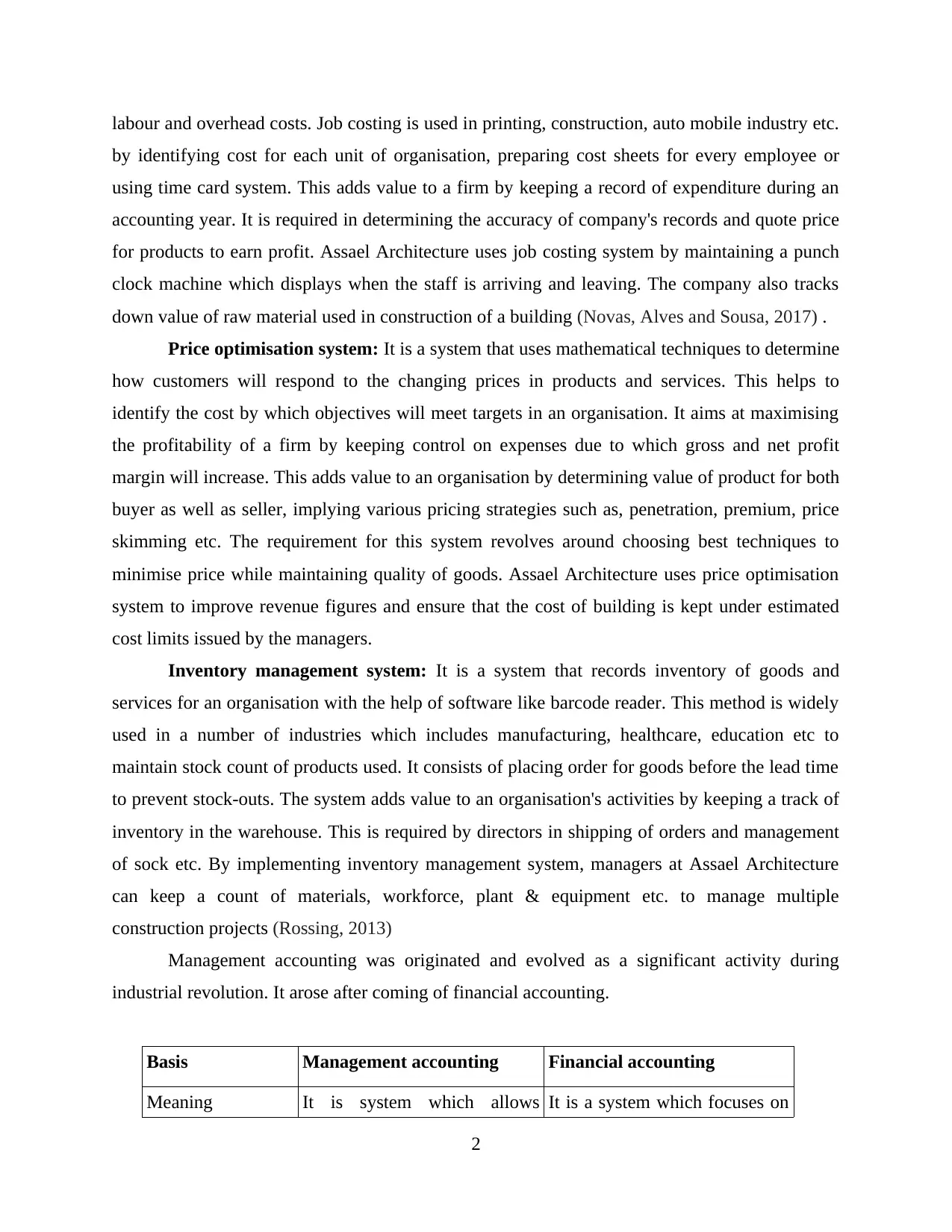
labour and overhead costs. Job costing is used in printing, construction, auto mobile industry etc.
by identifying cost for each unit of organisation, preparing cost sheets for every employee or
using time card system. This adds value to a firm by keeping a record of expenditure during an
accounting year. It is required in determining the accuracy of company's records and quote price
for products to earn profit. Assael Architecture uses job costing system by maintaining a punch
clock machine which displays when the staff is arriving and leaving. The company also tracks
down value of raw material used in construction of a building (Novas, Alves and Sousa, 2017) .
Price optimisation system: It is a system that uses mathematical techniques to determine
how customers will respond to the changing prices in products and services. This helps to
identify the cost by which objectives will meet targets in an organisation. It aims at maximising
the profitability of a firm by keeping control on expenses due to which gross and net profit
margin will increase. This adds value to an organisation by determining value of product for both
buyer as well as seller, implying various pricing strategies such as, penetration, premium, price
skimming etc. The requirement for this system revolves around choosing best techniques to
minimise price while maintaining quality of goods. Assael Architecture uses price optimisation
system to improve revenue figures and ensure that the cost of building is kept under estimated
cost limits issued by the managers.
Inventory management system: It is a system that records inventory of goods and
services for an organisation with the help of software like barcode reader. This method is widely
used in a number of industries which includes manufacturing, healthcare, education etc to
maintain stock count of products used. It consists of placing order for goods before the lead time
to prevent stock-outs. The system adds value to an organisation's activities by keeping a track of
inventory in the warehouse. This is required by directors in shipping of orders and management
of sock etc. By implementing inventory management system, managers at Assael Architecture
can keep a count of materials, workforce, plant & equipment etc. to manage multiple
construction projects (Rossing, 2013)
Management accounting was originated and evolved as a significant activity during
industrial revolution. It arose after coming of financial accounting.
Basis Management accounting Financial accounting
Meaning It is system which allows It is a system which focuses on
2
by identifying cost for each unit of organisation, preparing cost sheets for every employee or
using time card system. This adds value to a firm by keeping a record of expenditure during an
accounting year. It is required in determining the accuracy of company's records and quote price
for products to earn profit. Assael Architecture uses job costing system by maintaining a punch
clock machine which displays when the staff is arriving and leaving. The company also tracks
down value of raw material used in construction of a building (Novas, Alves and Sousa, 2017) .
Price optimisation system: It is a system that uses mathematical techniques to determine
how customers will respond to the changing prices in products and services. This helps to
identify the cost by which objectives will meet targets in an organisation. It aims at maximising
the profitability of a firm by keeping control on expenses due to which gross and net profit
margin will increase. This adds value to an organisation by determining value of product for both
buyer as well as seller, implying various pricing strategies such as, penetration, premium, price
skimming etc. The requirement for this system revolves around choosing best techniques to
minimise price while maintaining quality of goods. Assael Architecture uses price optimisation
system to improve revenue figures and ensure that the cost of building is kept under estimated
cost limits issued by the managers.
Inventory management system: It is a system that records inventory of goods and
services for an organisation with the help of software like barcode reader. This method is widely
used in a number of industries which includes manufacturing, healthcare, education etc to
maintain stock count of products used. It consists of placing order for goods before the lead time
to prevent stock-outs. The system adds value to an organisation's activities by keeping a track of
inventory in the warehouse. This is required by directors in shipping of orders and management
of sock etc. By implementing inventory management system, managers at Assael Architecture
can keep a count of materials, workforce, plant & equipment etc. to manage multiple
construction projects (Rossing, 2013)
Management accounting was originated and evolved as a significant activity during
industrial revolution. It arose after coming of financial accounting.
Basis Management accounting Financial accounting
Meaning It is system which allows It is a system which focuses on
2
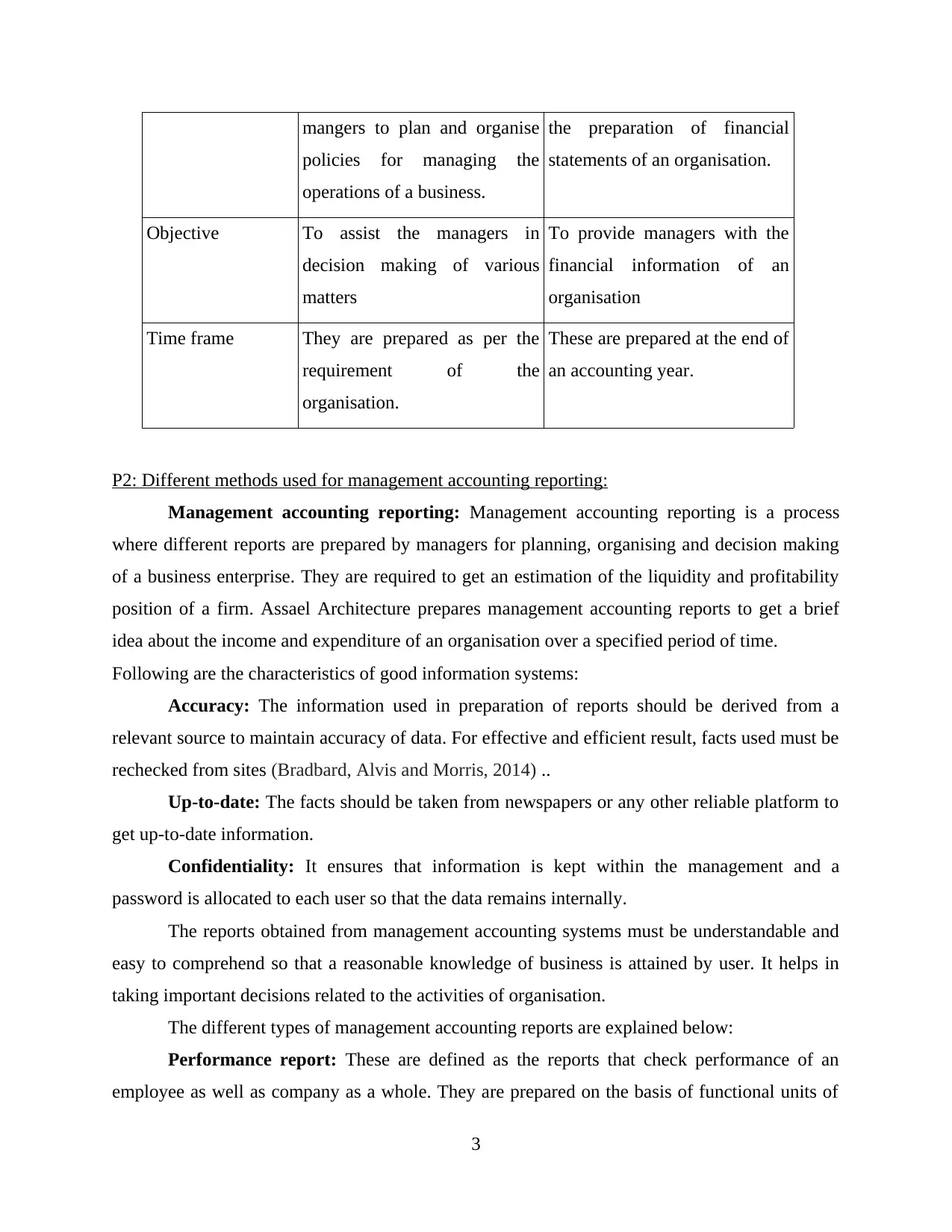
mangers to plan and organise
policies for managing the
operations of a business.
the preparation of financial
statements of an organisation.
Objective To assist the managers in
decision making of various
matters
To provide managers with the
financial information of an
organisation
Time frame They are prepared as per the
requirement of the
organisation.
These are prepared at the end of
an accounting year.
P2: Different methods used for management accounting reporting:
Management accounting reporting: Management accounting reporting is a process
where different reports are prepared by managers for planning, organising and decision making
of a business enterprise. They are required to get an estimation of the liquidity and profitability
position of a firm. Assael Architecture prepares management accounting reports to get a brief
idea about the income and expenditure of an organisation over a specified period of time.
Following are the characteristics of good information systems:
Accuracy: The information used in preparation of reports should be derived from a
relevant source to maintain accuracy of data. For effective and efficient result, facts used must be
rechecked from sites (Bradbard, Alvis and Morris, 2014) ..
Up-to-date: The facts should be taken from newspapers or any other reliable platform to
get up-to-date information.
Confidentiality: It ensures that information is kept within the management and a
password is allocated to each user so that the data remains internally.
The reports obtained from management accounting systems must be understandable and
easy to comprehend so that a reasonable knowledge of business is attained by user. It helps in
taking important decisions related to the activities of organisation.
The different types of management accounting reports are explained below:
Performance report: These are defined as the reports that check performance of an
employee as well as company as a whole. They are prepared on the basis of functional units of
3
policies for managing the
operations of a business.
the preparation of financial
statements of an organisation.
Objective To assist the managers in
decision making of various
matters
To provide managers with the
financial information of an
organisation
Time frame They are prepared as per the
requirement of the
organisation.
These are prepared at the end of
an accounting year.
P2: Different methods used for management accounting reporting:
Management accounting reporting: Management accounting reporting is a process
where different reports are prepared by managers for planning, organising and decision making
of a business enterprise. They are required to get an estimation of the liquidity and profitability
position of a firm. Assael Architecture prepares management accounting reports to get a brief
idea about the income and expenditure of an organisation over a specified period of time.
Following are the characteristics of good information systems:
Accuracy: The information used in preparation of reports should be derived from a
relevant source to maintain accuracy of data. For effective and efficient result, facts used must be
rechecked from sites (Bradbard, Alvis and Morris, 2014) ..
Up-to-date: The facts should be taken from newspapers or any other reliable platform to
get up-to-date information.
Confidentiality: It ensures that information is kept within the management and a
password is allocated to each user so that the data remains internally.
The reports obtained from management accounting systems must be understandable and
easy to comprehend so that a reasonable knowledge of business is attained by user. It helps in
taking important decisions related to the activities of organisation.
The different types of management accounting reports are explained below:
Performance report: These are defined as the reports that check performance of an
employee as well as company as a whole. They are prepared on the basis of functional units of
3
⊘ This is a preview!⊘
Do you want full access?
Subscribe today to unlock all pages.

Trusted by 1+ million students worldwide
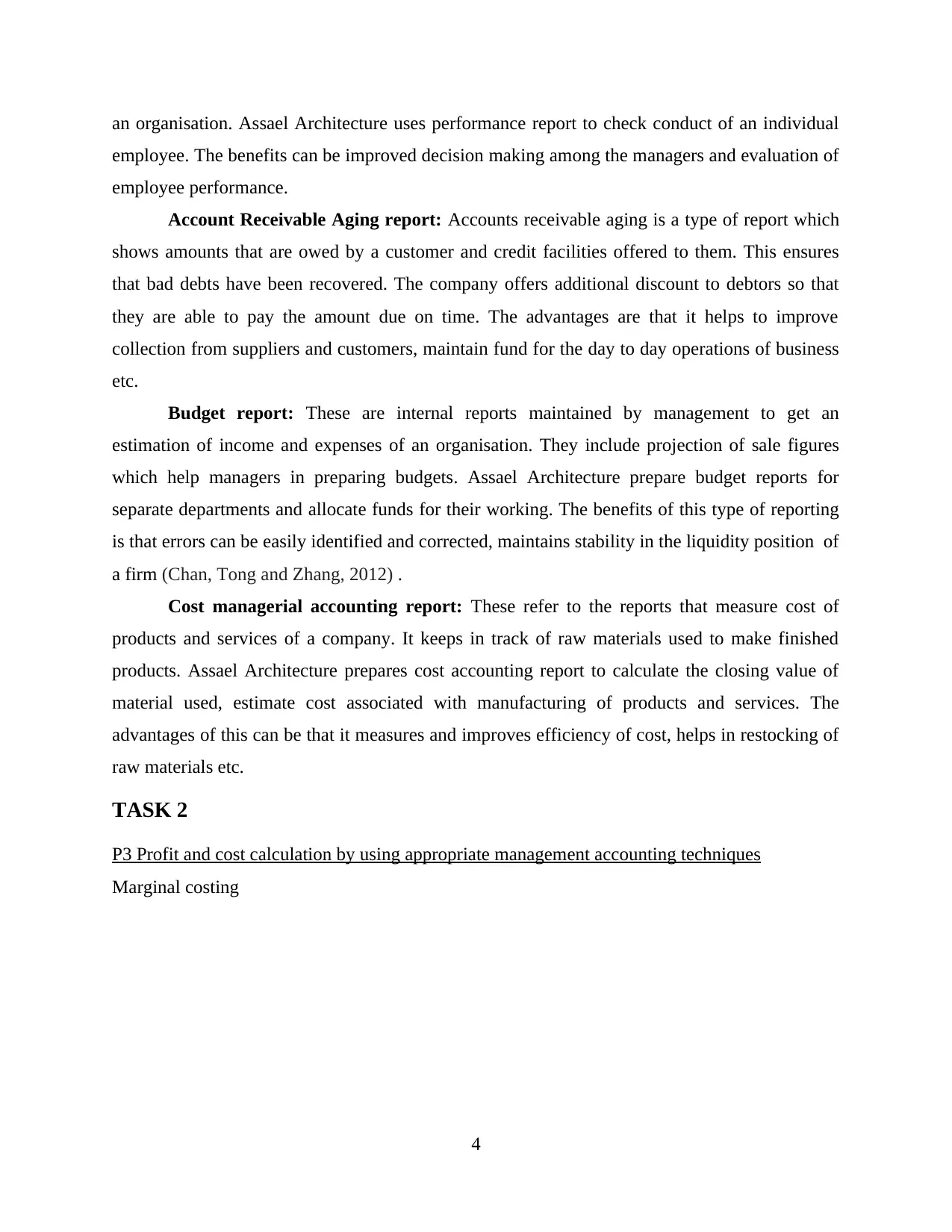
an organisation. Assael Architecture uses performance report to check conduct of an individual
employee. The benefits can be improved decision making among the managers and evaluation of
employee performance.
Account Receivable Aging report: Accounts receivable aging is a type of report which
shows amounts that are owed by a customer and credit facilities offered to them. This ensures
that bad debts have been recovered. The company offers additional discount to debtors so that
they are able to pay the amount due on time. The advantages are that it helps to improve
collection from suppliers and customers, maintain fund for the day to day operations of business
etc.
Budget report: These are internal reports maintained by management to get an
estimation of income and expenses of an organisation. They include projection of sale figures
which help managers in preparing budgets. Assael Architecture prepare budget reports for
separate departments and allocate funds for their working. The benefits of this type of reporting
is that errors can be easily identified and corrected, maintains stability in the liquidity position of
a firm (Chan, Tong and Zhang, 2012) .
Cost managerial accounting report: These refer to the reports that measure cost of
products and services of a company. It keeps in track of raw materials used to make finished
products. Assael Architecture prepares cost accounting report to calculate the closing value of
material used, estimate cost associated with manufacturing of products and services. The
advantages of this can be that it measures and improves efficiency of cost, helps in restocking of
raw materials etc.
TASK 2
P3 Profit and cost calculation by using appropriate management accounting techniques
Marginal costing
4
employee. The benefits can be improved decision making among the managers and evaluation of
employee performance.
Account Receivable Aging report: Accounts receivable aging is a type of report which
shows amounts that are owed by a customer and credit facilities offered to them. This ensures
that bad debts have been recovered. The company offers additional discount to debtors so that
they are able to pay the amount due on time. The advantages are that it helps to improve
collection from suppliers and customers, maintain fund for the day to day operations of business
etc.
Budget report: These are internal reports maintained by management to get an
estimation of income and expenses of an organisation. They include projection of sale figures
which help managers in preparing budgets. Assael Architecture prepare budget reports for
separate departments and allocate funds for their working. The benefits of this type of reporting
is that errors can be easily identified and corrected, maintains stability in the liquidity position of
a firm (Chan, Tong and Zhang, 2012) .
Cost managerial accounting report: These refer to the reports that measure cost of
products and services of a company. It keeps in track of raw materials used to make finished
products. Assael Architecture prepares cost accounting report to calculate the closing value of
material used, estimate cost associated with manufacturing of products and services. The
advantages of this can be that it measures and improves efficiency of cost, helps in restocking of
raw materials etc.
TASK 2
P3 Profit and cost calculation by using appropriate management accounting techniques
Marginal costing
4
Paraphrase This Document
Need a fresh take? Get an instant paraphrase of this document with our AI Paraphraser
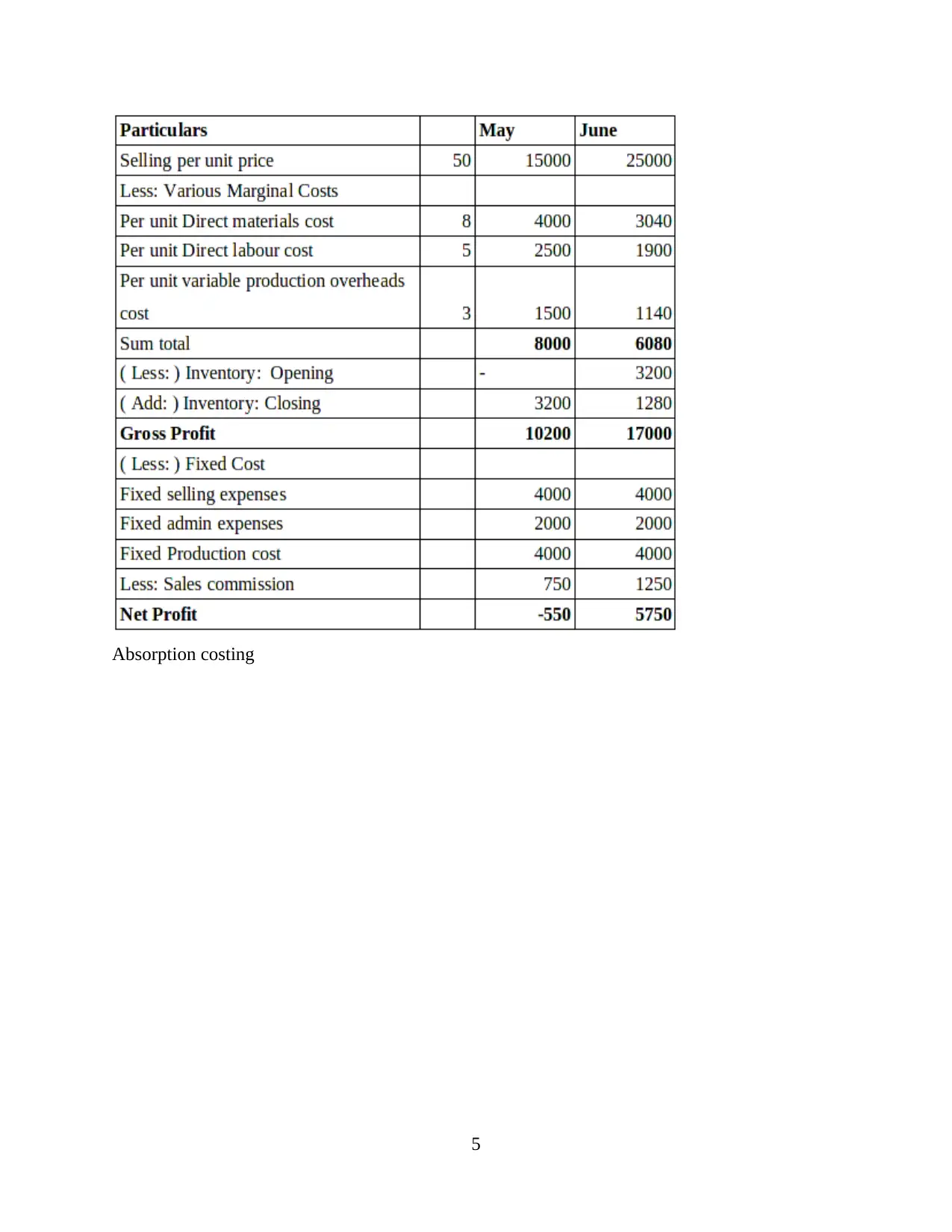
Absorption costing
5
5
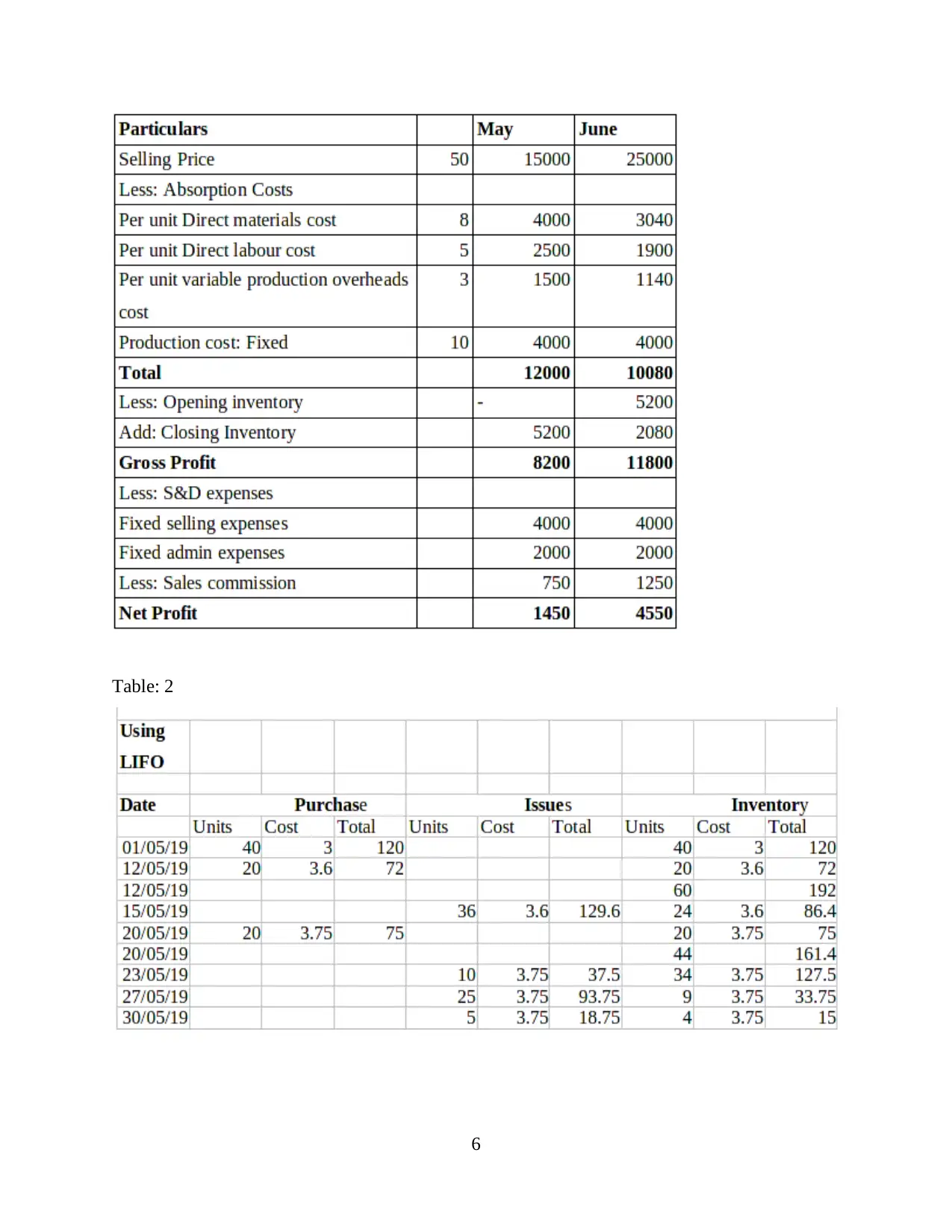
Table: 2
6
6
⊘ This is a preview!⊘
Do you want full access?
Subscribe today to unlock all pages.

Trusted by 1+ million students worldwide
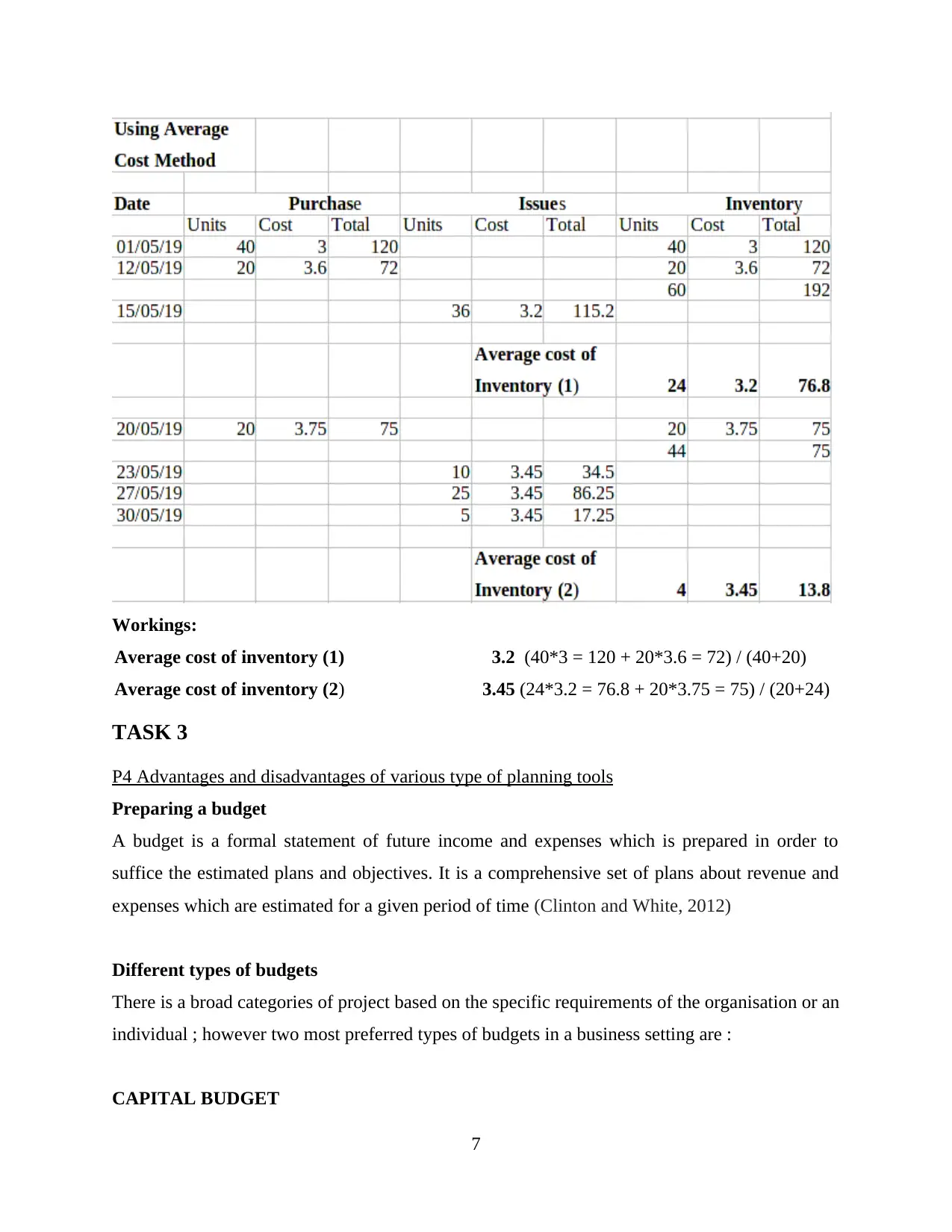
Workings:
Average cost of inventory (1) 3.2 (40*3 = 120 + 20*3.6 = 72) / (40+20)
Average cost of inventory (2) 3.45 (24*3.2 = 76.8 + 20*3.75 = 75) / (20+24)
TASK 3
P4 Advantages and disadvantages of various type of planning tools
Preparing a budget
A budget is a formal statement of future income and expenses which is prepared in order to
suffice the estimated plans and objectives. It is a comprehensive set of plans about revenue and
expenses which are estimated for a given period of time (Clinton and White, 2012)
Different types of budgets
There is a broad categories of project based on the specific requirements of the organisation or an
individual ; however two most preferred types of budgets in a business setting are :
CAPITAL BUDGET
7
Average cost of inventory (1) 3.2 (40*3 = 120 + 20*3.6 = 72) / (40+20)
Average cost of inventory (2) 3.45 (24*3.2 = 76.8 + 20*3.75 = 75) / (20+24)
TASK 3
P4 Advantages and disadvantages of various type of planning tools
Preparing a budget
A budget is a formal statement of future income and expenses which is prepared in order to
suffice the estimated plans and objectives. It is a comprehensive set of plans about revenue and
expenses which are estimated for a given period of time (Clinton and White, 2012)
Different types of budgets
There is a broad categories of project based on the specific requirements of the organisation or an
individual ; however two most preferred types of budgets in a business setting are :
CAPITAL BUDGET
7
Paraphrase This Document
Need a fresh take? Get an instant paraphrase of this document with our AI Paraphraser
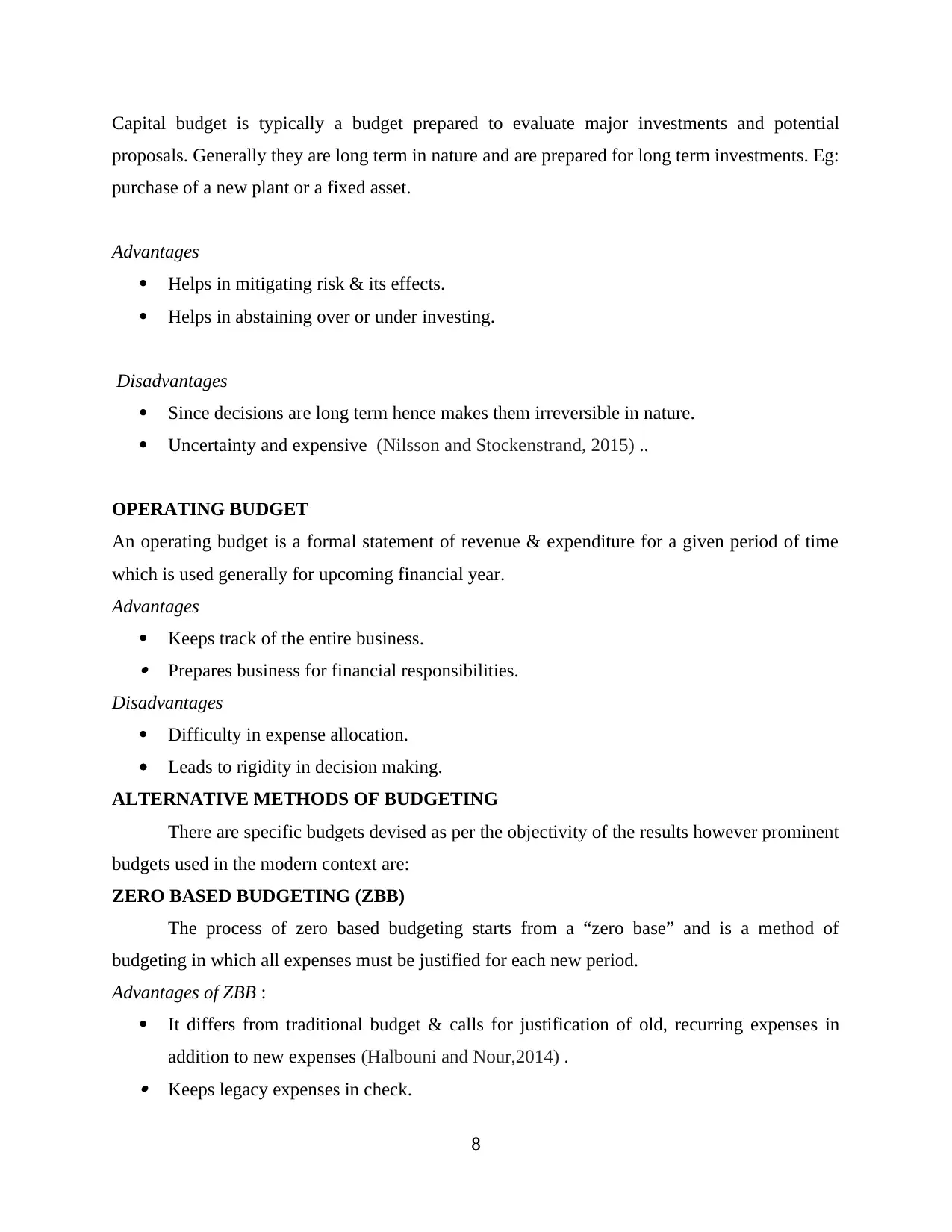
Capital budget is typically a budget prepared to evaluate major investments and potential
proposals. Generally they are long term in nature and are prepared for long term investments. Eg:
purchase of a new plant or a fixed asset.
Advantages
Helps in mitigating risk & its effects.
Helps in abstaining over or under investing.
Disadvantages
Since decisions are long term hence makes them irreversible in nature.
Uncertainty and expensive (Nilsson and Stockenstrand, 2015) ..
OPERATING BUDGET
An operating budget is a formal statement of revenue & expenditure for a given period of time
which is used generally for upcoming financial year.
Advantages
Keeps track of the entire business. Prepares business for financial responsibilities.
Disadvantages
Difficulty in expense allocation.
Leads to rigidity in decision making.
ALTERNATIVE METHODS OF BUDGETING
There are specific budgets devised as per the objectivity of the results however prominent
budgets used in the modern context are:
ZERO BASED BUDGETING (ZBB)
The process of zero based budgeting starts from a “zero base” and is a method of
budgeting in which all expenses must be justified for each new period.
Advantages of ZBB :
It differs from traditional budget & calls for justification of old, recurring expenses in
addition to new expenses (Halbouni and Nour,2014) . Keeps legacy expenses in check.
8
proposals. Generally they are long term in nature and are prepared for long term investments. Eg:
purchase of a new plant or a fixed asset.
Advantages
Helps in mitigating risk & its effects.
Helps in abstaining over or under investing.
Disadvantages
Since decisions are long term hence makes them irreversible in nature.
Uncertainty and expensive (Nilsson and Stockenstrand, 2015) ..
OPERATING BUDGET
An operating budget is a formal statement of revenue & expenditure for a given period of time
which is used generally for upcoming financial year.
Advantages
Keeps track of the entire business. Prepares business for financial responsibilities.
Disadvantages
Difficulty in expense allocation.
Leads to rigidity in decision making.
ALTERNATIVE METHODS OF BUDGETING
There are specific budgets devised as per the objectivity of the results however prominent
budgets used in the modern context are:
ZERO BASED BUDGETING (ZBB)
The process of zero based budgeting starts from a “zero base” and is a method of
budgeting in which all expenses must be justified for each new period.
Advantages of ZBB :
It differs from traditional budget & calls for justification of old, recurring expenses in
addition to new expenses (Halbouni and Nour,2014) . Keeps legacy expenses in check.
8
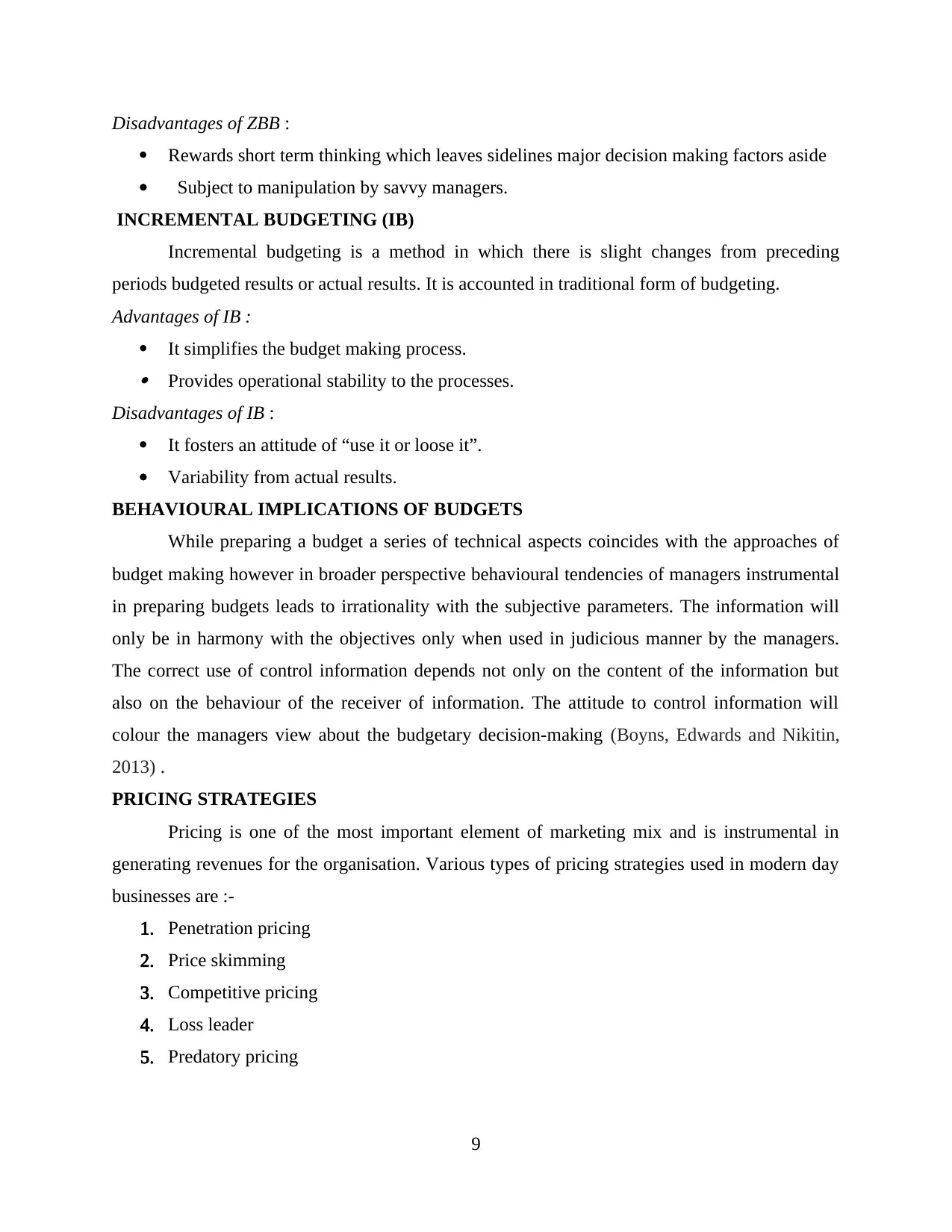
Disadvantages of ZBB :
Rewards short term thinking which leaves sidelines major decision making factors aside
Subject to manipulation by savvy managers.
INCREMENTAL BUDGETING (IB)
Incremental budgeting is a method in which there is slight changes from preceding
periods budgeted results or actual results. It is accounted in traditional form of budgeting.
Advantages of IB :
It simplifies the budget making process. Provides operational stability to the processes.
Disadvantages of IB :
It fosters an attitude of “use it or loose it”.
Variability from actual results.
BEHAVIOURAL IMPLICATIONS OF BUDGETS
While preparing a budget a series of technical aspects coincides with the approaches of
budget making however in broader perspective behavioural tendencies of managers instrumental
in preparing budgets leads to irrationality with the subjective parameters. The information will
only be in harmony with the objectives only when used in judicious manner by the managers.
The correct use of control information depends not only on the content of the information but
also on the behaviour of the receiver of information. The attitude to control information will
colour the managers view about the budgetary decision-making (Boyns, Edwards and Nikitin,
2013) .
PRICING STRATEGIES
Pricing is one of the most important element of marketing mix and is instrumental in
generating revenues for the organisation. Various types of pricing strategies used in modern day
businesses are :-
1. Penetration pricing
2. Price skimming
3. Competitive pricing
4. Loss leader
5. Predatory pricing
9
Rewards short term thinking which leaves sidelines major decision making factors aside
Subject to manipulation by savvy managers.
INCREMENTAL BUDGETING (IB)
Incremental budgeting is a method in which there is slight changes from preceding
periods budgeted results or actual results. It is accounted in traditional form of budgeting.
Advantages of IB :
It simplifies the budget making process. Provides operational stability to the processes.
Disadvantages of IB :
It fosters an attitude of “use it or loose it”.
Variability from actual results.
BEHAVIOURAL IMPLICATIONS OF BUDGETS
While preparing a budget a series of technical aspects coincides with the approaches of
budget making however in broader perspective behavioural tendencies of managers instrumental
in preparing budgets leads to irrationality with the subjective parameters. The information will
only be in harmony with the objectives only when used in judicious manner by the managers.
The correct use of control information depends not only on the content of the information but
also on the behaviour of the receiver of information. The attitude to control information will
colour the managers view about the budgetary decision-making (Boyns, Edwards and Nikitin,
2013) .
PRICING STRATEGIES
Pricing is one of the most important element of marketing mix and is instrumental in
generating revenues for the organisation. Various types of pricing strategies used in modern day
businesses are :-
1. Penetration pricing
2. Price skimming
3. Competitive pricing
4. Loss leader
5. Predatory pricing
9
⊘ This is a preview!⊘
Do you want full access?
Subscribe today to unlock all pages.

Trusted by 1+ million students worldwide
1 out of 16
Related Documents
Your All-in-One AI-Powered Toolkit for Academic Success.
+13062052269
info@desklib.com
Available 24*7 on WhatsApp / Email
![[object Object]](/_next/static/media/star-bottom.7253800d.svg)
Unlock your academic potential
Copyright © 2020–2025 A2Z Services. All Rights Reserved. Developed and managed by ZUCOL.





